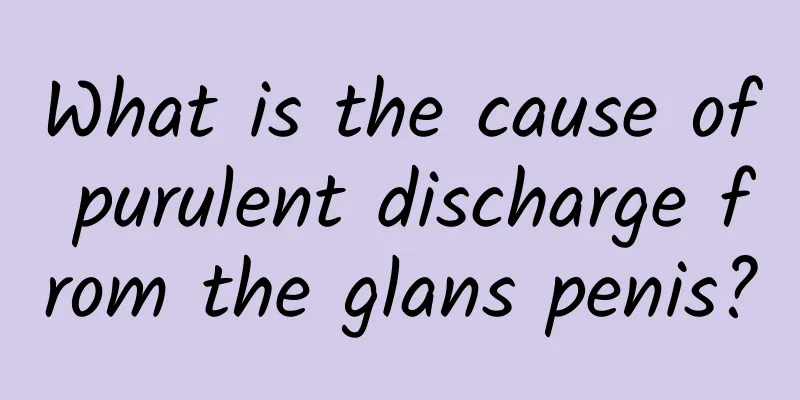Treatment for white foam in urine

|
I believe everyone knows the importance of urination. If our urination is abnormal, we must pay attention to it and go to the hospital for consultation in time. Some male friends may find a lot of white foam in their urine when urinating. This symptom brings great psychological pressure to male friends. So what exactly causes this symptom and how can we treat it? 1. Antimicrobial therapy The discovery of pathogenic pathogens in prostatic fluid culture is the basis for selecting antibacterial drug treatment. If patients with non-bacterial prostatitis have signs of bacterial infection and general treatment is ineffective, they can also be appropriately treated with antibacterial drugs. When choosing antibacterial drugs, it is necessary to pay attention to the presence of a prostate-blood barrier composed of lipid membranes between the prostate acini and the microcirculation, which hinders the passage of water-soluble antibiotics and greatly reduces the therapeutic effect. When prostate stones are present, the stones can become a shelter for bacteria. The above factors constitute the difficulty in the treatment of chronic bacterial prostatitis, which requires a longer course of treatment and is prone to recurrence. Currently, quinolone drugs such as ofloxacin or levofloxacin are recommended. If ineffective, continue to use it for 8 weeks. If recurrence occurs and the bacterial species remains unchanged, switch to preventive doses to reduce acute attacks and relieve symptoms. If long-term use of antibiotics induces serious side effects, such as pseudomembranous colitis, diarrhea, and the growth of intestinal resistant strains, the treatment plan needs to be changed. Whether non-bacterial prostatitis is suitable for treatment with antibacterial drugs is still controversial in the clinic. Patients with "aseptic" prostatitis can also use drugs that are effective against bacteria and mycoplasmas, such as quinolones, SMZ-TMP or TMP alone, used in combination with tetracycline and quinolones or used intermittently. If antibiotic treatment is ineffective and it is confirmed to be aseptic prostatitis, antibiotic treatment should be discontinued. In addition, using a double balloon catheter to block the prostatic urethra and injecting antibiotic solution from the urethral cavity back into the prostatic duct can also achieve the purpose of treatment. Type I is mainly treated with broad-spectrum antibiotics, symptomatic treatment and supportive treatment. Type II is recommended to be treated with oral antibiotics, and sensitive drugs are selected. The course of treatment is 4-6 weeks, during which the patient should be evaluated for the efficacy. Type III can first take oral antibiotics for 2 to 4 weeks and then evaluate the efficacy. At the same time, non-steroidal anti-inflammatory drugs, α-receptor antagonists, M-receptor antagonists, etc. are used to improve urination symptoms and pain. Type IV does not require treatment. 2. Anti-inflammatory and analgesic drugs Nonsteroidal anti-inflammatory drugs can improve symptoms. Generally, indomethacin is taken orally or in suppositories. Chinese medicine also has certain effects in using anti-inflammatory, heat-clearing, detoxifying, and hardness-softening drugs. Allopurinol can reduce the concentration of uric acid in the whole body and prostatic fluid. Theoretically, as a free radical scavenger, it can also remove active oxygen components, reduce inflammation, and relieve pain. It is an optional auxiliary treatment method. 3. Physical therapy Prostate massage can empty the concentrated secretions in the prostate duct and drain the infection focus in the obstructed area of the gland. Therefore, for stubborn cases, prostate massage can be performed every 3 to 7 days while using antibiotics. A variety of physical factors are used for prostate physiotherapy, such as microwave, radio frequency, ultrashort wave, medium wave and hot water sitz bath, which are beneficial for relaxing the prostate, posterior urethral smooth muscle and pelvic floor muscle, enhancing antibacterial efficacy and relieving pain symptoms. In the above article, we introduced a symptom that male friends may experience when urinating, that is, white foam in the urine. We know that the main cause of white foam in urine is prostatitis. The above article introduces in detail the treatment methods for white foam in urine. |
<<: Reasons why men's urine smells
>>: Reasons for white sediment in urine
Recommend
Epididymitis examination
Men's physical health is very important, but ...
Introduction to the efficacy and preparation of wolfberry and honeysuckle soup
Honeysuckle and wolfberry are also a good health-...
What are the symptoms of glans tumor?
The glans penis is a very important part of the m...
Early symptoms of impotence
What is impotence? I believe that many male frien...
How to remove eye bags for men
Many people have eye bags. When you have eye bags...
Semen is grayish white
Male semen is a liquid that is discharged through...
Is it okay for men to shave their pubic hair?
For men, it is beneficial to trim the pubic hair ...
Pictures of red spots on testicles?
There are dozens of common male diseases in moder...
Can men recover from HPV infection?
HPV is a viral infection. There are about 100 dif...
How can men lose weight on the inner thighs?
Weight loss seems to have always been a topic tha...
Symptoms of impotence and premature ejaculation
For men with impotence, this is a headache. In ot...
10 Steps to Male Enhancement Massage
Massaging some areas and acupoints can achieve th...
These 4 parts of a man's body are the dirtiest
1. Scalp Studies have found that there are about ...
What is the cause of itching on both sides of the scrotum?
Many men have encountered some men's diseases...
How many days does it take for sperm to be replenished?
How long does it take to replenish sperm? How to ...









